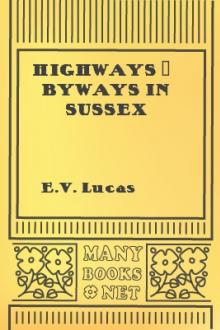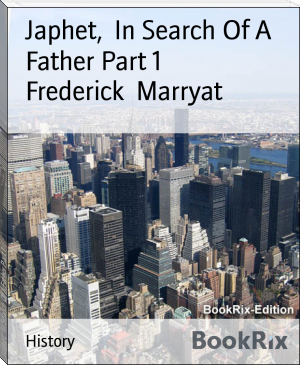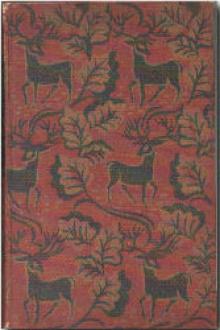Highways & Byways in Sussex by E. V. Lucas (e reader pdf best .txt) 📕

- Author: E. V. Lucas
- Performer: -
Book online «Highways & Byways in Sussex by E. V. Lucas (e reader pdf best .txt) 📕». Author E. V. Lucas
"April 15th, 1715. Paid my uncle Courtness 15d. for a small bottle of Daffey's Elixir.
"July 18th, 1715. I went to Bolney and agreed with Edw. Jenner to dig sandstone for setting up my father's tombstone, at 5s. I gave him 6d. to spend in drink that he might be more careful.
"August 7th, (Sunday) 1715. I was not at church as my head ached very much.
"November 22nd, 1716. Fisht the great pond and put 220 of the biggest carp into the new pond, and 18 of the biggest tench. Put also 358 store carp into the flat stew, and 36 tench; and also 550 very small carp into a hole in the low field.
"November 24th, 1716. Fisht the middle pond. Put 66 large carp into the new pond, and 380 store tench into the flat stew, and 12 large carp, 10 large tench, and 57 middle sized tench into the hovel field stew.
"June 12th, 1717. I was at the cricket match at Dungton Gate towards night.
"January 24th, 1718. A mountebank came to our towne to-day. He calls himself Dr. Richard Harness. Mr. Scutt and I drank tea with the tumbler. Of his tricks I am no judge: but he appears to me to play well on the fiddle.
"January 30th (Friday), 1719. King Charles' Martyrdom. I was not at church, as my head ached very much.
"February 28th, 1719. We had news of the Chevalier de St. George, the Pretender, being taken and carried into the Castle of Milan.
"September 19th, 1719. John Parsons began his year last Tuesday. He is to shave my face twice a week, and my head once a fortnight, and I am to give him 100 faggots per annum.
"September 30th, 1719. Talked to Mrs. Beard, for Allan Savage, about her horse that was seized by the officers at Brighton running brandy.
"December 5th, 1719. My Lord Treep put a ferral and pick to my stick. [My Lord Treep was a tinker named Treep who lived in Treep's Lane. My Lord Burt, who is also mentioned in the diary, was a farrier.]
"July 28th, 1721. Paid Harry Wolvin of Twineham, for killing an otter in our parish. [An otter, of course, was a serious enemy to the owner of stews and ponds.]
"February 7th, 1722. Will and Jack went to Lewes to see a prize fight between Harris and another.
"September 18th, 1727. Dined at Mr. Hazelgrove's and cheapened a tombstone."
Thomas Marchant was buried September 17, 1728.
Less than two miles west of Hurstpierpoint is Albourne, so hidden away that one might know this part of the country well and yet be continually overlooking it. The western high road between Brighton and London passes within a stone's throw of Albourne, but one never suspects the existence, close by, of this retired village, so compact and virginal and exquisitely old fashioned. It is said that after the execution of Charles I Bishop Juxon lived for a while at Albourne Place during the Civil War, and once escaped the Parliamentary soldiers by disguising himself as a bricklayer. There is a priest's hiding hole in the house.
Some three miles north of Albourne is Twineham, another village which, situated only on a by-road midway between two lines of railway, has also preserved its bloom. Here, at the end of the seventeenth and beginning of the eighteenth centuries, at Hickstead Place, a beautiful Tudor mansion that still stands, lived Richard Stapley, another of the Sussex diarists whose MSS. have been selected for publication by the Sussex Archæological Society. I quote a few passages:—
"In ye month of November, 1692, there was a trout found in ye Poyningswish, in Twineham, which was 29 inches long from ye top of ye nose to ye tip of ye taile; and John fflint had him and eat him. He was left in a low slank after a fflood, and ye water fell away from him, and he died. The fish I saw at John fflint's house ye Sunday after they had him: and at night they boiled him for supper, but could not eat one halfe of him; and there was six of them at supper; John fflint and his wife Jane, and four of their children; and ye next day they all fell on him again, and compassed him."
Here we have the spectacle of a good man struggling with accuracy:—"August 19th, 1698. Paid Mr. Stheward for Dr. Comber's paraphrase on ye Common Prayer, 20s. and 6d. for carriage. I paid it at ye end of ye kitchen table next ye chamber stairs door, and nobody in ye room but he and I. No, it was ye end of ye table next ye parlour.
"April 26th, 1709. I bought a salmon-trout of William Lindfield of Grubbs, in Bolney, which he caught ye night before in his net, by his old orchard, which was wounded by an otter. The trout weighed 11 lbs. and ½; and was 3 foot 2 inches long from end to end, and but 2 foot 9 inches between ye eye and ye forke." There is also a record of a salmon trout being caught at Bolney early in the last century, which weighed 22lbs. and was sent to King George IV. at Brighton.
I must quote a prescription from the diary:—"To cure the hoopingcough:—get 3 field mice, flaw them, draw them, and roast one of them, and let the party afflicted eat it; dry the other two in the oven until they crumble to a powder, and put a little of this powder in what the patient drinks at night and in the morning." Mice played, and still play in remote districts, a large part in the rural pharmacopeia. A Sussex doctor once told me that he had directed the mother of a boy at Portslade to put some ice in a bag and tie it on the boy's forehead. When, the next day, the doctor asked after his patient, the mother replied briskly:—"Oh, Tommy's better, but the mice are dead."
The Stapley family ate an oatmeal pudding made in the following manner:—
Richard Stapley's diary was continued by his son Anthony and grandson John. The most pleasing among the printed extracts is this:—"1736, May the 21st. The white horse was buried in the saw-pit in the Laine's wood. He was aged about thirty-five years, as far as I could find of people that knew him foaled. He had been in his time as good a horse as ever man was owner of, and he was buried in his skin being a good old horse."
Ditchling
Ditchling. CHAPTER XXI DITCHLINGStanmer Park and Dr. Johnson—The Roman way down Ditchling Beacon—Sussex folk in London—Jacob's Post—The virtues of gibbets—Mr. John Burgess's diary.
Another good walk from Brighton begins with a short railway journey to Falmer on the Lewes line. Then strike into Stanmer Park, the seat of the Earl of Chichester, a descendant of the famous Sussex Pelhams, with the church and the little village of Stanmer on the far edge of it, and so up through the hollows and valleys to Ditchling Beacon. Dr. Johnson's saying of the Downs about Brighton, that "it was a country so truly desolate that if one had a mind to hang oneself for desperation at being obliged to live there, it would be difficult to find a tree on which to fasten a rope," proves beyond question that his horse never took him Stanmer way, for the park is richly wooded.
On Ditchling Beacon, one of the noblest of the Sussex hills and the second if not the first in height of all the range (the surveys differ, one giving the palm to Duncton) the Romans had a camp, and the village of Ditchling may still be gained by the half-subterranean path that our conquerors dug, so devised that a regiment might descend into the Weald unseen.
Ditchling is a quiet little village on high ground, where Alfred the Great once had a park. The church is a very interesting and graceful specimen of early English architecture, dating from the 13th century. A hundred and more years ago water from a chalybeate spring on the common was drunk by Sussex people for rheumatism and other ills; but the spring has lost its fame. The village could not well be more out of the movement, yet an old lady living in the neighbourhood who, when about to visit London for the first time, was asked what she expected to find, replied, "Well, I can't exactly tell, but I suppose something like the more bustling part of Ditchling." A kindred story is told of a Sussex man who, finding himself in London for the first time, exclaimed with astonishment—"What a queer large place! Why, it ain't like Newick and it ain't like Chailey."
Old House at Ditchling
Old House at Ditchling.On Ditchling Common are the protected remains of a stake known as Jacob's Post. A stranger requested to supply this piece of wood with the origin of its label would probably adventure long before hitting upon the right tack; for Jacob, whose name has in this familiar connection a popular and almost an endearing sound, was Jacob Harris, a Jew pedlar of astonishing turpitude, who, after murdering three persons at an inn on Ditchling Common and plundering their house, was hanged at Horsham in the year 1734, and afterwards suspended, as a lesson, to the gibbet, of which this post—Jacob's Post—is the surviving relic.
All gibbets, it is said, are "good" for something, and a piece of Jacob's Post carried on the person is sovran against toothache. A Sussex archæologist tells of an old lady, a resident on Ditchling Common for more than eighty years, whose belief in the Post was so sound that her pocket contained a splinter of it long after all her teeth had departed.
From extracts from the diary of Mr. John Burgess, tailor, sexton and Particular Baptist, of Ditchling, which are given in the Sussex Archæological Collections, I quote here and there:—
"August 1st, 1785. There was a cricket match at Lingfield Common between Lingfield in Surrey and all the county of Sussex, supposed to be upwards of 2,000 people.
"June 29th, 1786. Went to Lewes with some wool to Mr. Chatfield, fine wool at 8-5-0 per pack. Went to dinner with Mr. Chatfield. Had boiled Beef, Leg of Lamb and plum Pudden. Stopped there all the afternoon. Mr. Pullin was there; Mr. Trimby and the Curyer, &c., was there. We had a good deal of religious conversation, particularly Mr. Trimby.
"June 11th, 1787. Spent 3 or 4 hours with some friends in Conversation upon Moral and religious Subjects; the inquiry was the most easy and natural evedences of ye existence and attributes of ye supream Being—in discussing upon the Subject we was nearly agreed and propose meeting again every first monday after the fool Moon to meet at 4 and break-up at 8.
"March 14th, 1788. Went to Fryersoake to a Bull Bait to Sell My dog. I seld him for 1 guineay upon condition he was Hurt, but as he received no Hurt I took him back again at the same price. We had a good dinner; a round of Beef Boiled, a good piece roasted, a Lag of Mutton and





Comments (0)